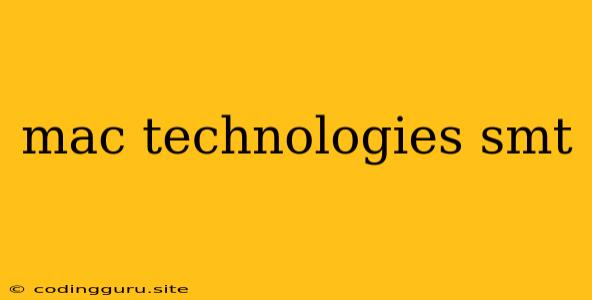What is MAC Technology and How Does It Relate to SMT?
The term "MAC" in the context of electronics manufacturing refers to Machine Automatic Control, and it plays a crucial role in Surface Mount Technology (SMT).
What is SMT?
Surface Mount Technology (SMT) is a process used in electronics manufacturing to mount electronic components directly onto the surface of a printed circuit board (PCB). This differs from traditional "through-hole" technology, where components are inserted through holes in the board and soldered on the other side. SMT has become the dominant assembly technique for electronics due to its numerous advantages, including:
- Smaller size and higher density: SMT components are significantly smaller than their through-hole counterparts, enabling smaller and more complex boards.
- Reduced assembly costs: The automation capabilities of SMT machines lead to faster production and lower labor costs.
- Improved performance: SMT components have a higher performance due to their smaller size and better electrical connections.
What is MAC Technology?
Machine Automatic Control (MAC) refers to the technology that enables the automated control and operation of SMT machines. These machines handle various tasks, including:
- Component placement: Precisely placing electronic components onto the PCB.
- Soldering: Applying solder paste and melting it to create permanent connections.
- Inspection: Detecting and eliminating defective components or solder joints.
MAC technology is essential for achieving the speed, accuracy, and efficiency that SMT requires. It uses sophisticated algorithms and sensors to ensure that each component is placed in the correct location and soldered properly.
How Does MAC Technology Work in SMT?
The core of MAC technology lies in the software and hardware systems that control the SMT machines. Here's a breakdown of the key components:
- Vision systems: These systems use cameras and image processing algorithms to identify and locate components, ensuring accurate placement.
- Feeders and component handling: Automated systems that store and supply components to the placement heads.
- Placement heads: Mechanical arms equipped with nozzles that pick up and place components with high precision.
- Soldering systems: Apply and melt solder paste, typically using infrared or convection heating techniques.
- Inspection systems: Utilize various methods, including X-ray and optical inspection, to detect defects in solder joints and component placement.
The Benefits of MAC Technology in SMT
The implementation of MAC technology brings several benefits to SMT manufacturing:
- Increased efficiency: Automated processes reduce manual labor and significantly increase production speed.
- Improved accuracy: The precise control provided by MAC systems minimizes errors in component placement and soldering.
- Reduced costs: Automation leads to higher throughput and lower labor costs, resulting in overall cost savings.
- Enhanced quality: MAC technology ensures consistent and high-quality assembly, reducing defects and improving product reliability.
- Flexibility and scalability: SMT machines equipped with MAC technology can be easily reconfigured for different PCB sizes and component types, making them adaptable to various production needs.
Examples of MAC Technology in SMT
MAC technology is widely used in SMT manufacturing, with several industry-standard implementations:
- Pick-and-place machines: These machines use sophisticated algorithms and vision systems to accurately place components onto the PCB.
- Solder paste dispensers: These machines use precise control to apply the correct amount of solder paste to the pads on the PCB.
- Automated optical inspection (AOI) systems: These systems use cameras and algorithms to inspect the quality of solder joints and component placement.
- X-ray inspection systems: These systems use X-ray imaging to detect hidden defects in solder joints and internal components.
Conclusion
Machine Automatic Control (MAC) is an indispensable technology in Surface Mount Technology (SMT). It drives automation, improves efficiency, and enhances the quality of electronics manufacturing processes. As technology continues to evolve, we can expect even more sophisticated MAC systems to emerge, further optimizing SMT production and enabling the development of increasingly complex electronic devices.
